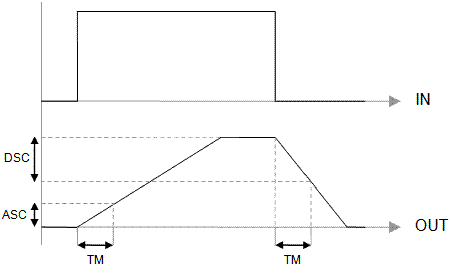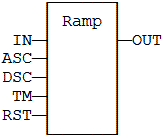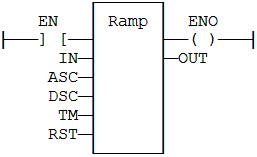![]()
 Function - Limit the ascendance or descendance of a signal.
Function - Limit the ascendance or descendance of a signal.
Inputs
|
Input |
Data Type |
Range |
Unit |
Default |
Description |
|---|---|---|---|---|---|
|
IN |
REAL |
|
|
|
Input signal. |
|
ASC |
REAL |
Maximum ascendance during time base. |
|||
|
DSC |
REAL |
Maximum descendant during time base. |
|||
|
TM |
TIME |
Time base. |
|||
|
RST |
BOOL |
Reset. |
Outputs
|
Output |
Data Type |
Range |
Unit |
Description |
|---|---|---|---|---|
|
OUT |
REAL |
|
|
Ramp signal. |
Remarks
- Parameters are not updated constantly.
- They are taken into account only when the:
- The block is called the first time.
- Reset input (RST) is TRUE.
- In these two situations, the output is set to the value of IN input.
- They are taken into account only when the:
- ASC and DSC give the maximum ascendant and descendant growth during the TB
time base.
- Both must be expressed as positive numbers.
Time Diagram

FBD Language Example

FFLD Language Example
- In the FFLD Language, the operation is executed only if the input rung (EN) is TRUE.
- The output rung (ENO) keeps the same value as the input rung.
- The function is executed only if EN is TRUE.
- ENO keeps the same value as EN.

IL Language Example
(* MyRamp is a declared instance of RAMP function block *)
Op1: CAL MyRamp (IN, ASC, DSC, TM, RST)
FFLD MyBlinker.OUT
ST OUT
ST Language Example
(* MyRamp is a declared instance of RAMP function block *)
MyRamp (IN, ASC, DSC, TM, RST);
OUT := MyBlinker.OUT;






